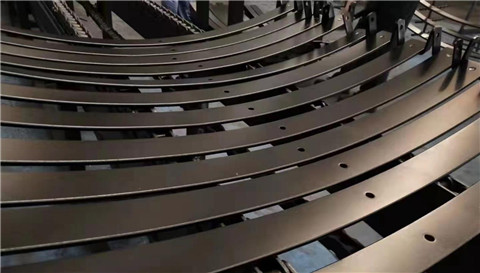What are leaf springs made of? Common Materials Used in Leaf Springs

Steel Alloys
Steel is the most common material used, especially for heavy-duty applications such as trucks, buses, trailers, and railway vehicles. Steel has high tensile strength and durability, which enable it to withstand high stresses and loads without breaking or deforming.
Different types of steel are chosen based on their composition and physical qualities. The most commonly used steel grades include:
5160 steel: A low-alloy type containing roughly 0.6% carbon and 0.9% chromium. Its high toughness and resistance to wear make it perfect for heavy-duty leaf springs.
9260 steel: This is a high-silicon variant with about 0.6% carbon and 2% silicon. Known for its flexibility and shock absorption, it’s typically chosen for light-duty leaf springs.
1095 steel: Containing about 0.95% carbon, this high-carbon steel is extremely hard and wear-resistant, making it great for high-performance leaf springs.
Composite Materials
Composite materials are relatively new entrants in the field of leaf springs, but they have gained popularity in recent years due to their advantages over conventional steel. Composite materials are made of two or more different materials that are combined to create a new material with enhanced properties. Some of the most common composite materials used in leaf springs are:
Fiberglass is a composite material made of glass fibers embedded in a resin matrix. Fiberglass has a low weight and high strength-to-weight ratio, which improves fuel efficiency and handling of the vehicle. Fiberglass also has excellent corrosion resistance and thermal stability, which increase its lifespan and performance under varying environmental conditions.
Carbon fiber is a composite material made of carbon fibers embedded in a resin matrix. Carbon fiber has an even lower weight and higher strength-to-weight ratio than fiberglass, which further enhances the fuel efficiency and handling of the vehicle. Carbon fiber also has superior stiffness and vibration damping, which reduce noise and improve ride quality.
Why These Materials Are Chosen
Steel’s Strength and Durability
Steel is a metal alloy that has high tensile strength and resistance to deformation, making it ideal for heavy-duty applications that require durability and reliability. Steel can withstand high loads, shocks, and stresses without breaking or losing their shape.
They are also resistant to corrosion, wear, and fatigue, which prolongs their lifespan and reduces maintenance costs. Some of the industries where steel leaf springs excel are mining, construction, agriculture, and military, where they are used in trucks, trailers, tractors, tanks, and other heavy equipment.
Composites’ Innovation and Lightweight Design
Composites, made of two or more substances, offer enhanced properties. Tailored for specific needs like weight reduction and performance, composite leaf springs, crafted from fiber-reinforced polymers like carbon fiber, are light yet strong. They boost fuel efficiency, speed, and handling while offering superior comfort and noise reduction compared to steel springs. They excel in sports cars, racing vehicles, electric models, and aerospace applications.
In conclusion, understanding this question offers invaluable insights into the innovation and engineering behind our vehicles. The fusion of carefully selected materials and meticulous manufacturing processes ensures that these essential components continue to support and enhance our driving experiences for years to come.
Carhome Auto Parts Company can produce leaf springs of various materials such as 60si2mn, sup9, and 50crva. We can customize leaf springs according to customer needs. If you need it, please contact us.
Post time: Feb-26-2024






